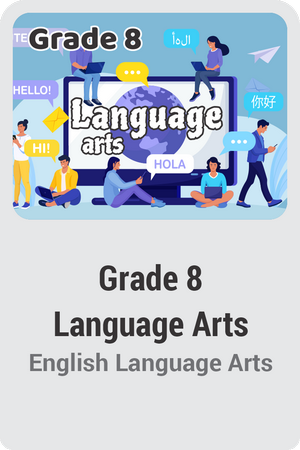
Course Overview:
Through reading, writing, and rhetoric, students in the Grade 8 Language Arts course examine how authors fine-tune and utilize their craft to create texts with purpose. Students continue to develop the reading, writing, language, and speaking/listening skills necessary for success in high school, college, career, and beyond. Students evaluate and analyze voice, purpose, diction, syntax, and rhetoric in historical speeches, informational texts, and classic and contemporary literature through guided readings, interactive practice, and formal assessments. They also refine their narrative, informational, and argumentative writing skills through the repeated practice of planning, drafting, revising, and editing their written work.
Prerequisites:
Grade 7 Language Arts
Required Materials:
- Disk space on your computer as well as external devices to back up your files (flash drive, external hard drive, etc.)
- Word processing program (Microsoft Word or similar)
Students will read an independent reading selection in segment 2 from a list of options provided by instruction.
- Anne Frank: Diary of a Young Girl by Anne Frank
- Black Beauty by Anna Sewell
- The War of the Worlds by H.G. Wells
- Untwine by Edwidge Danticat
- White Fang by Jack London
*Students are responsible for obtaining their independent reading selection.
Free Downloads:
- Java
- Windows Media Player
- Apple iTunes
Syllabus:
Segment 1
Reading Comprehension/Informational & Expository Writing:
- Explaining author's purpose through diction and syntax
- Examining the ways literary elements interact
- Analyzing plot structure
- Tracking the development of two or more themes in literature
- Determining point of view and perspective
- Identifying symbolism in literary texts
- Uncovering word meanings through context clues
- Determining the central idea of a text
- Writing effective summaries
- Utilizing parallel structure in writing
- Examining informational text structures and features
- Locating credible sources based on bias, origin, and purpose
- Avoiding plagiarism
- Citing sources correctly
- Formatting the Works Cited page
- Using signal phrases and transitions in academic writing
- Writing effective informational introductions, body paragraphs, and conclusions
- Formulating thesis statements for academic writing
- Using precise language and domain-specific vocabulary
- Integrating interesting grammar to enhance voice
- Editing and revising with purpose
- Connecting the use of figurative language devices to a text's meaning
- Identifying and correcting logical fallacies
- Using semicolons effectively
- Understanding active and passive voice
- Determining word meaning through affixes and root words
Module 01: A Strong Foundation
- 01.00 A Strong Foundation Checklist
- 01.00 A Strong Foundation Pretest
- 01.01 Literary Foundations
- 01.02 Perspectives and Themes
- 01.03 Symbolism in Literature
- 01.04 Being a Word Detective
- 01.05 Find the Central Idea
- 01.06 Idea Development
- 01.07 Phrases and Clauses
Module 02: Get the Facts
- 02.00 Get the Facts Checklist
- 02.01 Getting Research Ready
- 02.02 A Close Look at Organization
- 02.03 Cite Your Sources
- 02.05 Focus on the Introduction
- 02.06 Connect and Support Your Ideas
- 02.07 Syntax and Voice
- 02.08 Putting Your Essay Together
- 02.09 Revise and Reflect
Module 03: Words Have Power
- 03.00 Words Have Power Checklist
- 03.01 Figuratively Speaking
- 03.02 Figuring Out Figurative Language
- 03.03 Mastering Semicolons
- 03.04 The Name Game
- 03.05 Fallacies: Why So Informal?
- 03.06 Be a Fallacy Fixer
- 03.07 Active and Passive Voice
Segment 2
Reading Comprehension/Argumentative Writing/Narrative Writing:
- Analyzing how rhetorical appeals and devices support an argument
- Planning and organizing an effective argument
- Identifying elements of an effective claim, counterclaim, and rebuttal
- Effectively supporting a claim with well-researched evidence
- Using elaborative details to communicate and clarify knowledge to an audience
- Analyzing how a poem's use of structure and poetic devices affect the meaning
- Comparing archetypes across literature
- Identifying various types of narratives
- Clarifying point of view and perspective
- Tracking the development of conflict and theme
- Revising for parallel structure
- Using digital media to create a novel review
- Planning a narrative based on a plot archetype
- Using narrative techniques to enhance creative writing
Module 04: Convincing Claims
- 04.00 Convincing Claims Checklist
- 04.00 Convincing Claims Pretest
- 04.01 Rhetoric Rundown
- 04.02 Appealing Rhetoric
- 04.03 Changing Perspectives
- 04.04 Organization is Key
- 04.05 Ready, Set, Argue
- 04.07 Support Does a Body Good
- 04.08 Bring it Home
- 04.09 Stand Out From the Crowd
Module 05: Narrative Knowledge
- 05.00 Narrative Knowledge Checklist
- 05.01 Poetic Language with Purpose
- 05.02 Poetic Foundations
- 05.03 Do You Hear What I Hear?
- 05.05 It’s Story Time
- 05.06 Finding the Symbolism
- 05.07 Typical Archetypes
- 05.08 Narrative Q & A
Module 06: Tell Me a Story
- 06.00 Tell Me a Story Checklist
- 06.01 An Interesting Point of View
- 06.02 Planning Your Narrative
- 06.03 An Interesting Beginning
- 06.05 Your Narrative Voice
- 06.06 All Good Things Must Come to an End
- 06.07 Advanced My Side of the Story


